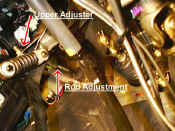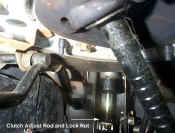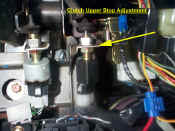
Metallic Puck Style Clutch Discs |
|
| They wont die. They can take a ton of abuse and wont turn into kitty hair. Even when they get so hot that the pressure plate warps and the diaphragm looses it's spring pressure, they wont fully die. Cool, right? The down side of that "never dying" is that it allows them to keep slipping, then heat up and grab. The slipping with out dying makes the surface cracks in the flywheel and pressure plate that will eventually cause the flywheel to come apart. Whether it is a stock flywheel, lightened stock flywheel or a Chromoly flywheel, puck clutches make cracks that kill flywheels, that kill bell housings and more. They have their place but I don't think in a street car. In a race car that gets regular inspections they can be fine. Also most puck clutches have a solid hub center that will contribute to horrible coast down gear noise (worse in an AWD). | |
|
Street style disc |
Puck style disc |
| Puck style discs can put up
with a lot of heat. You also need to slip them more
to keep from breaking things. More heat made. When a street disc is
slipped too much and gets hot, it disintegrates and turns
into kitty hair. You wont keep driving on an
overheated street disc. If you get a puck disc to
the same temp, nothing happens. That's nice because you can keep racing.
But that heat is hell on the flywheel. Just like brake
rotors crack when over heated, so do flywheels.
If you keep racing on a cracked flywheel, you will eventually saw your tranny in half. It does not matter if it is a lightened or stock flywheel. We get flywheels sent in to us regularly that are too cracked to use. Those guys cry like babies when they have to pay a core charge. From the cores we get, I would guess one out of ten racers are driving around with some cracking. |
|
Clutch AdjustmentEvery time the clutch or flywheel gets replaced the clutch needs to be adjusted. Many people assume incorrectly that since it is a hydraulic system that it does not need adjustment or that it does not need adjustment. Wrong. You want a little free play off the floor before the clutch begins to grab. You also will need a little free play at the top of the pedal travel. |
|
 |
2GLoosen the lock nut on the adjuster rod and you'll be able to rotate the rod by hand. If getting the right free play off the floor makes it so that you loose the free play at the top of the pedal travel, you will need to adjust the upper travel stop. The upper travel stop is the cruise control switch. |
 |
1G1G clutch pedal linkage is a little more complex. The upper stop adjuster is directly above the clutch pedal. The adjuster rod is over to the right above the gas pedal. 1G cars with the typical higher mileage of the average 1G Eclipse and the more complex linkage, 1G cars will often suffer from loose or worn linkage. |
 |
If you can wiggle the pedal with one hand, and you don't feel the clutch master cylinder rod moving with the other hand, you are suffering from this problem. The solution is to replace the pedal assembly, or possibly weld the linkage where it is loose. Either one requires more work to remove and reinstall the pedal assembly, you don't even want to know how much hassle it is. |
2G Pedal "Pump Up"If you are fighting an inconsistent pedal adjustment in a 2G, adjust the upper pedal stop adjuster so that you gain additional free play at the top of the pedal travel. Loosen the lock nut and turn the whole switch to get the necessary freeplay (see above pic). You'll probably end up with the clutch pedal sitting a bit higher than the brake pedal. If this is your problem, you will notice that the pedal suddenly gets very tight and the release point will suddenly move up a lot, this is the cause. 2Gs need free play at the top of the pedal travel. If it is close to no travel and right on the edge, then it pumps up. Only 2Gs have a relief valve in the master cylinder that needs to be uncovered so fluid can go back into the reservoir on the clutch release. If not, it gets tighter and tighter and tighter. Then it may slowly relieve the pressure and it is back to normal. Just a 2G thing. You need more free play at the top of the pedal travel. Left unchecked, the pedal will pump up more and more. The clutch will begin to slip since it is as if you are driving around with your foot on the clutch pedal. Also it plays hell on the crankshaft thrust bearings. The constant pressure pushes the clutch release bearing onto the clutch and flywheel. When centrifugal force throws the clutch release fingers outwards, they make additional pressure on the thrust bearings of the crank. This is an additional factor in short lived crankshaft release bearings and an additional potential cause for crankwalk.
|
|
2G "Ghost Pedal"On very light foot pressure on a 2Gthe pedal drops to the floor all by it's self. ?? Yes. The little rubber seal in the pic above gets a little nick in it or a piece of dirt under it. On a regular pedal push, the seal seals fine and the clutch works normally. On a very light push, the seal does not seal well and fluid will bypass it. Since the 2Gs have a heavy assist spring, the additional assist is enough pressure to keep the pedal going towards the floor all alone. Quite disturbing to watch. Replacing or rebuilding the master cylinder will fix this. A close up pic of the troublesome valve inside the master cylinder: |
|
Pedal To The Floor After A Left TurnYou are screwed ;-) The thrust bearings on the crankshaft are so worn, that the crankshaft flops so far to the right on a left turn that most of the pedal travel in the clutch system is used just to put the crankshaft back to the left. You have "Crankwalk". Go here to see how bad off you are. |
|